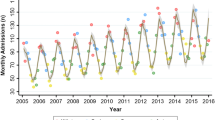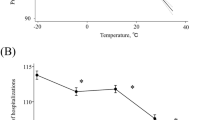Abstract
Outdoor ambient weather has been hypothesized to be responsible for the seasonal distribution of cardiac arrhythmias. Because people spend most of their time indoors, we hypothesized that weather-related arrhythmia risk would be better estimated using an indoor measure or an outdoor measure that correlates well with indoor conditions, such as absolute humidity. The clinical records of 203 patients in eastern Massachusetts, USA, with an implantable cardioverter-defibrillator were abstracted for arrhythmias between 1995 and 2002. We used case-crossover methods to examine the association between weather and ventricular arrhythmia (VA). Among 84 patients who experienced 787 VAs, lower estimated indoor temperature (odds ratio (OR)=1.16, 95% confidence interval (CI) 1.05–1.27 for a 1 °C decrease in the 24-h average) and lower absolute humidity (OR=1.06, 95% CI 1.03–1.08 for a 0.5 g/m3 decrease in the 96-h average) were associated with increased risk. Lower outdoor temperature increased risk only in warmer months, likely attributable to the poor correlation between outdoor and indoor temperature during cooler months. These results suggest that lower temperature and drier air are associated with increased risk of VA onset among implantable cardioverter-defibrillator patients.
This is a preview of subscription content, access via your institution
Access options
Subscribe to this journal
Receive 6 print issues and online access
$259.00 per year
only $43.17 per issue
Buy this article
- Purchase on Springer Link
- Instant access to full article PDF
Prices may be subject to local taxes which are calculated during checkout





Similar content being viewed by others
Abbreviations
- AH:
-
absolute humidity
- CAD:
-
coronary artery disease
- d.f.:
-
degree of freedom
- ECG:
-
electrocardiogram
- ICD:
-
implantable cardioverter-defibrillator
- PM2.5:
-
particulate matter <2.5 μm in aerodynamic diameter
- SCD:
-
sudden cardiac death
- VA:
-
ventricular arrhythmia
References
Anand K, Aryana A, Cloutier D, Hee T, Esterbrooks D, Mooss AN et al. Circadian, daily, and seasonal distributions of ventricular tachyarrhythmias in patients with implantable cardioverter-defibrillators. Am J Cardiol 2007; 100: 1134–1138.
Muller D, Lampe F, Wegscheider K, Schultheiss HP, Behrens S . Annual distribution of ventricular tachycardias and ventricular fibrillation. Am Heart J 2003; 146: 1061–1065.
Frost L, Johnsen SP, Pedersen L, Husted S, Engholm G, Sorensen HT et al. Seasonal variation in hospital discharge diagnosis of atrial fibrillation: a population-based study. Epidemiology 2002; 13: 211–215.
Watanabe E, Kuno Y, Takasuga H, Tong M, Sobue Y, Uchiyama T et al. Seasonal variation in paroxysmal atrial fibrillation documented by 24-hour holter electrocardiogram. Heart Rhythm 2007; 4: 27–31.
Gerber Y, Jacobsen SJ, Killian JM, Weston SA, Roger VL . Seasonality and daily weather conditions in relation to myocardial infarction and sudden cardiac death in Olmsted County, Minnesota, 1979 to 2002. J Am Coll Cardiol 2006; 48: 287–292.
Reichert TA, Simonsen L, Sharma A, Pardo SA, Fedson DS, Miller MA . Influenza and the winter increase in mortality in the United States, 1959-1999. Am J Epidemiol 2004; 160: 492–502.
Mercer JB . Cold—an underrated risk factor for health. Environ Res 2003; 92: 8–13.
Dilaveris P, Synetos A, Giannopoulos G, Gialafos E, Pantazis A, Stefanadis C . CLimate Impacts on Myocardial infarction deaths in the Athens TErritory: the CLIMATE study. Heart 2006; 92: 1747–1751.
Čulić V, Eterovic D, Miric D, Giunio L, Lukin A, Fabijanic D . Triggering of ventricular tachycardia by meteorologic and emotional stress: protective effect of beta-blockers and anxiolytics in men and elderly. Am J Epidemiol 2004; 160: 1047–1058.
Pimental M, Grüdtner L, Zimerman LI . Seasonal variation of ventricular tachycardia assessed by 24-hour holter monitoring. Arq Bras Cardiol 2006; 87: 362–365.
Fries RP, Heisel AG, Jung JK, Schieffer HJ . Circannual variation of malignant ventricular tachyarrhythmias in patients with implantable cardioverter-defibrillators and either coronary artery disease or idiopathic dilated cardiomyopathy. Am J Cardiol 1997; 79: 1194–1197.
Hoppe P, Martinac I . Indoor climate and air quality: review of current and future topics in the field of ISB study group 10. Int J Biometeorol 1998; 42: 1–7.
Ahrens CD . Meteorology Today: An Introduction to Weather, Climate, and the Environment. West Publishing Company: St. Paul, MN. 1991.
Nguyen JL, Schwartz J, Dockery DW . The relationship between indoor and outdoor temperature, apparent temperature, relative humidity, and absolute humidity. Indoor Air 2013 doi:10.1111/ina.12052.
Baughman A, Arens EA . Indoor humidity and human health—Part I: Literature review of health effects of humidity-influenced indoor pollutants. ASHRAE Trans 1996; 102 (Pt. 1): 193–211.
Stevenson WG, John RM . Ventricular arrhythmias in patients with implanted defibrillators. Circulation 2011; 124: e411–e414.
Jackson LR, Daubert JP, Thomas KL . Expanding the benefits of implantable cardioverter-defibrillator therapy: “is less more”? Prog Cardiovasc Dis 2012; 54: 372–378.
Pires LA, Lehmann MH, Steinman RT, Baga JJ, Schuger CD . Sudden death in implantable cardioverter-defibrillator recipients: clinical context, arrhythmic events and device responses. J Am Coll Cardiol 1999; 33: 24–32.
National Weather Service Western Region Headquarters. Vapor pressure http://www.wrh.noaa.gov/slc/projects/wxcalc/formulas/vaporPressure.pdf . Accessed June 15, 2011.
National Aeronautics and Space Administration. Equations for the determination of humidity from dewpoint and psychrometric data. NASA Technical Note D-8401. Washington, DC: National Aeronautics and Space Administration; 1977 http://www.nasa.gov/centers/dryden/pdf/87878main_H-937.pdf. Accessed June 15, 2011.
Rich DQ, Schwartz J, Mittleman MA, Link M, Luttmann-Gibson H, Catalano PJ et al. Association of short-term ambient air pollution concentrations and ventricular arrhythmias. Am J Epidemiol 2005; 161: 1123–1132.
Lumley T, Levy D . Bias in the case-crossover design: implication for studies of air pollution. Environmetrics 2000; 11: 689–704.
Levy D, Lumley T, Sheppard L, Kaufman J, Checkoway H . Referent selection in case-crossover analyses of acute health effects of air pollution. Epidemiology 2001; 12: 186–192.
Govindarajulu US, Spiegelman D, Thurston SW, Ganguli B, Eisen EA . Comparing smoothing techniques in Cox models for exposure-response relationships. Stat Med 2007; 26: 3735–3752.
Shaman J, Kohn M . Absolute humidity modulates influenza survival, transmission, and seasonality. Proc Natl Acad Sci USA 2009; 106: 3243–3248.
Shaman J, Pitzer VE, Viboud C, Grenfell BT, Lipsitch M . Absolute humidity and the seasonal onset of influenza in the continental United States. PLoS Biol 2010; 8: e1000316.
Shoji M, Katayama K, Sano K . Absolute humidity as a deterministic factor affecting seasonal influenza epidemics in Japan. Tohoku J Exp Med 2011; 224: 251–256.
van Noort SP, Aguas R, Ballesteros S, Gomes MG . The role of weather on the relation between influenza and influenza-like illness. J Theor Biol 2011; 298C: 131–137.
Lowen AC, Mubareka S, Steel J, Palese P . Influenza virus transmission is dependent on relative humidity and temperature. PLoS Pathog 2007; 3: 1470–1476.
Centers for Disease Control and Prevention. United States surveillance data: 1997-1998 through 2009-2010 seasons http://www.cdc.gov/flu/weekly/ussurvdata.htm . Accessed November 20, 2011.
Koken PJ, Piver WT, Ye F, Elixhauser A, Olsen LM, Portier CJ . Temperature, air pollution, and hospitalization for cardiovascular diseases among elderly people in Denver. Environ Health Perspect 2003; 111: 1312–1317.
Ljungman PL, Berglind N, Holmgren C, Gadler F, Edvardsson N, Pershagen G et al. Rapid effects of air pollution on ventricular arrhythmias. Eur Heart J 2008; 29: 2894–2901.
Rich DQ, Kim MH, Turner JR, Mittleman MA, Schwartz J, Catalano PJ et al. Association of ventricular arrhythmias detected by implantable cardioverter defibrillator and ambient air pollutants in the St Louis, Missouri metropolitan area. Occup Environ Med 2006; 63: 591–596.
McGuinn L, Hajat S, Wilkinson P, Armstrong B, Anderson HR, Monk V et al. Ambient temperature and activation of implantable cardioverter defibrillators. Int J Biometeorol 2012 57: 655–662.
Schneider A, Schuh A, Maetzel FK, Ruckerl R, Breitner S, Peters A . Weather-induced ischemia and arrhythmia in patients undergoing cardiac rehabilitation: another difference between men and women. Int J Biometeorol 2008; 52: 535–547.
Ren C, O'Neill MS, Park SK, Sparrow D, Vokonas P, Schwartz J . Ambient temperature, air pollution, and heart rate variability in an aging population. Am J Epidemiol 2011; 173: 1013–1021.
Liu W, Lian Z, Liu Y . Heart rate variability at different thermal comfort levels. Eur J Appl Physiol 2008; 103: 361–366.
Abrignani MG, Corrao S, Biondo GB, Renda N, Braschi A, Novo G et al. Influence of climatic variables on acute myocardial infarction hospital admissions. Int J Cardiol 2009; 137: 123–129.
Meyer P, Guiraud T, Curnier D, Juneau M, Gayda M, Nozza A et al. Exposure to extreme cold lowers the ischemic threshold in coronary artery disease patients. Can J Cardiol 2010; 26: e50–e53.
Estes NA . Predicting and preventing sudden cardiac death. Circulation 2011; 124: 651–656.
Haugaa KH, Edvardsen T, Amlie JP . Prediction of life-threatening arrhythmias—still an unresolved problem. Cardiology 2011; 118: 129–137.
Malik M . Ventricular gradient and cardiac risk. Europace 2011; 13: 605–607.
Myerburg RJ, Kessler KM, Castellanos A . Sudden cardiac death: epidemiology, transient risk, and intervention assessment. Ann Intern Med 1993; 119: 1187–1197.
Peterson TC, Zhang XB, Brunet-India M, Vázquez-Aguir JL . Changes in North American extremes derived from daily weather data. J Geophys Res 2008; 113: D07113.
Solomon S, Qin D, Manning M, Chen Z, Marquis M, Averyt KB et al (eds). Climate Change 2007: The Physical Science Basis. Contribution of Working Group I to the Fourth Assessment Report of the Intergovernmental Panel on Climate Change. Cambridge University Press: Cambridge, UK, and New York, NY. 2007.
Acknowledgements
This study was funded in part by grants from the Health Effects Institute (grant 98-14), the National Institute of Environmental Health Sciences (NIEHS) (grants ES09825 and R21ES020194), and the Harvard-NIEHS Center for Environmental Health (NIEHS ES00002). Particulate air pollution measurements at the Harvard School of Public Health were funded in part by the Environmental Protection Agency (EPA)-Harvard Center on Ambient Particle Health Effects (EPA grants R827353 and RD83479801), and measurements in South Boston were funded by contracts with the Boston Edison and Gillette companies (Boston, MA, USA). JLN received support from the Benjamin Greely Ferris, Jr. Fellowship Fund, and NIEHS grant T32ES007069. JS received support from NIEHS R21ES020695 and NIA R21AG040027. We thank the fellows and researchers who abstracted the ICD data. We especially thank David Q. Rich, who organized the abstraction of data and processed these data.
Author information
Authors and Affiliations
Corresponding author
Ethics declarations
Competing interests
The authors declare no conflict of interest.
Rights and permissions
About this article
Cite this article
Nguyen, J., Laden, F., Link, M. et al. Weather and triggering of ventricular arrhythmias in patients with implantable cardioverter-defibrillators. J Expo Sci Environ Epidemiol 25, 175–181 (2015). https://doi.org/10.1038/jes.2013.72
Received:
Accepted:
Published:
Issue Date:
DOI: https://doi.org/10.1038/jes.2013.72
Keywords
This article is cited by
-
Ambient temperature variability and blood pressure in a prospective cohort of 50,000 Chinese adults
Journal of Human Hypertension (2022)
-
Association of ambient temperature with the outcomes in witnessed out-of-hospital cardiac arrest patients: a population-based observational study
Scientific Reports (2019)
-
The association of air temperature with cardiac arrhythmias
International Journal of Biometeorology (2017)
-
Hospitalizations from Hypertensive Diseases, Diabetes, and Arrhythmia in Relation to Low and High Temperatures: Population-Based Study
Scientific Reports (2016)



